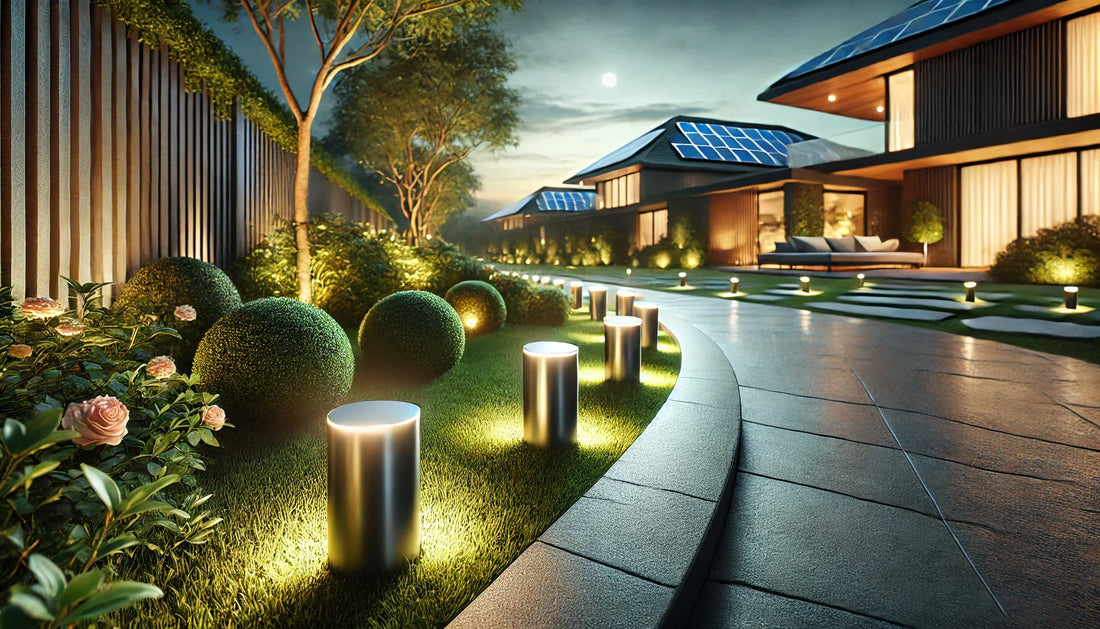
How Do Solar Lights Work?
Solar lighting can create an elegant, well-lit atmosphere, while illuminating dark spaces without the need for electrical wiring or complicated installations. Additionally, solar lighting is more environmentally friendly as it relies on renewable energy from the sun and doesn't emit greenhouse gases like carbon.
People who enjoy the glow of solar lights may know they are powered by the sun and appreciate their eco-friendly nature. However, they might not fully understand the mechanics behind solar lighting, how to maximize their power, or the benefits of switching from traditional lighting systems to solar-powered ones.
From the Sun to Stored Energy
To understand how solar lights work, it's important to grasp the concept of solar cells. All outdoor solar lighting harnesses sunlight and converts it into electricity using solar cells.
These cells are called photovoltaic (PV) cells, which are excellent at absorbing the sun's energy. Throughout the day, as long as sunlight is available, these cells absorb solar energy and create an electrical charge that moves through the light fixture’s panel.
The solar cells are connected to the light’s battery, which converts and stores this power. This power exists as chemical energy until needed to produce light. When it gets dark, a photoreceptor detects the absence of light, and the battery starts powering a light-emitting diode bulb (LED) using the stored energy. The diode in an LED is a semiconductor that allows electrons to move between two points, creating electromagnetic energy, which serves as light for the solar fixture.
The light radiates from the fixture until daylight returns, when the photoreceptor detects the light and shuts off, or until the fixture's battery runs out of stored energy.
Maximizing Solar Power
When considering solar-powered lighting, it's crucial to account for geographic and location-specific factors that may impact how well solar lights and panels absorb and convert energy.
Most areas in the United States are suitable for solar-powered lamps or lighting systems. However, it's essential to consider the required hours of sunlight for the lamp or system before investing in solar. The solar cells must receive the recommended sunlight regularly.
If a specific city, town, or remote location receives enough sunlight, the exact position of the panels should be considered. Self-contained solar lamps must be placed in sunlight, while lighting systems with separate solar panels need only the panel situated in a sunny location.
Depending on the sunlight received, outdoor solar lighting systems may illuminate the entire evening or have a shorter runtime. During winter, when there are shorter days and less sunlight, solar-powered lamps may operate for 30 to 50% less time. This can be mitigated by sizing the system to offset daylight changes during winter.
In areas with significant snowfall, it's crucial to position solar panels where they won't be blocked by snow or where snow can be easily cleared. Additionally, trees, bushes, or other foliage should not create shade that affects the panel's ability to receive sunlight and convert it to power.
Benefits of Solar Energy
There are numerous reasons individuals, families, or businesses might switch to solar-powered lighting.
Solar lights are environmentally friendly as they are powered by sunlight, a reliable renewable energy source. Solar energy does not emit carbon or other harmful greenhouse gases, making it an appealing option for those striving to be greener and more carbon-conscious.
Solar-powered lamps can also be cost-effective in the long run. After the initial investment, electricity costs decrease, resulting in significant savings over time.
During natural disasters or power outages, solar lighting systems can be more secure than traditional lighting. Buildings with solar-powered lighting remain unaffected while others lose power.
Solar lighting requires less maintenance than traditional electric lighting. Solar panels and lamps need occasional cleaning and battery changes every five to seven years, unlike electrical lighting that requires frequent servicing and upkeep.
Solar lights are often safer than electric lights because they don't require wiring, reducing the risk of tripping or dealing with chaotic cords. Pets and children are also safer around solar lighting systems.
Moreover, solar lighting can be aesthetically pleasing, adding another reason to consider switching to solar.
Applications of Solar Lighting
Solar-panel lighting is used in various settings. Solar-powered lamps serve as street lights, illuminating parking lots, city streets, highways, sidewalks, and more. Solar-powered traffic stoplights are also becoming more common.
Solar sign lights illuminate street signs, store signs, and billboards in sunny areas. Cities and towns are investing in solar floodlights for use during natural disasters or emergencies. Businesses, governments, non-profits, and homeowners use powerful solar lamps as security lights around buildings or homes to deter trespassers. These lights can be connected to timers or motion detectors.
On a smaller scale, solar-powered desk lamps are used in work or home offices. Some have built-in solar panels, while others are connected to external PV panels installed at homes or offices. Outdoor solar-lighting fixtures are used around yards, gardens, playgrounds, ponds, patios, walkways, and more.
Convert to Solar with SolarLightHome
SolarLightHome specializes in a wide variety of solar-powered lamps, table lights, lanterns, architectural lights, and lightscaping with focus on style and modern design. Our solar lamps generate between 300 to 500 lumens of warm light (3000K), depending on the piece, and the LED light can be brightened or dimmed to one’s liking.
Explore our full range of solar-powered lamps, panels, and products here. For more information about our solar-lighting options, fill out our contact form.
